The rise of the cocktail pub
Since the age of the Roman Empire the public house has been a staple of the world’s drinking culture. We chart its development and examine how boozers are embracing cocktails to meet customers’ expectations.
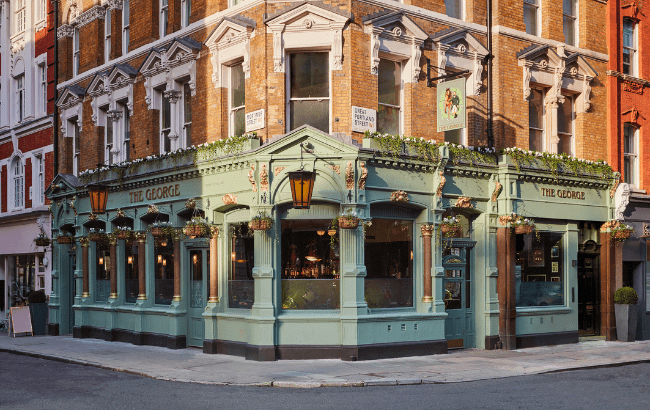
*This feature was first published in the April issue of The Spirits Business magazine.
In the long list of answers to the question ‘but what have the Romans ever done for us?’, ‘give us the British pub’ is one that might surprise you. Of course, with roots dating back to 43AD, it didn’t begin life as the sticky-carpeted, home‐from‐home we think of now, but the Roman taberna is where the pub’s origin story begins.
Tabernas were shops that sold wine, and were built alongside Roman roads and in towns to help quench the thirst of the legionary troops. However, the British love of ale meant the taberna adapted to provide the locals with their favourite tipple, with the word eventually being corrupted to ‘tavern’.
Fast‐forward to the reign of King Henry VII, and taverns, alehouses and inns all collectively became known as public houses, and by 1577 it is estimated there was approximately one pub for every 200 people in England and Wales. In 2020, there were 58 pubs per 100,000 people in the UK, according to ONS data. Yes, the pub, for all the socioeconomic challenges it faces, remains a lynchpin of British and Irish society. But after a few stagnant decades, in which the offering’s only modification came in the form of the gastropub concept in the 1990s, it is once again going through a period of reform, with outside influence this time coming from high‐end cocktail bars.
The cocktail pub bridges the gap between the traditional country pub and the city-based cocktail bar. It is a real tradition‐meets-modern blend that offers consumers a new drinking experience that benefits from being entirely familiar.
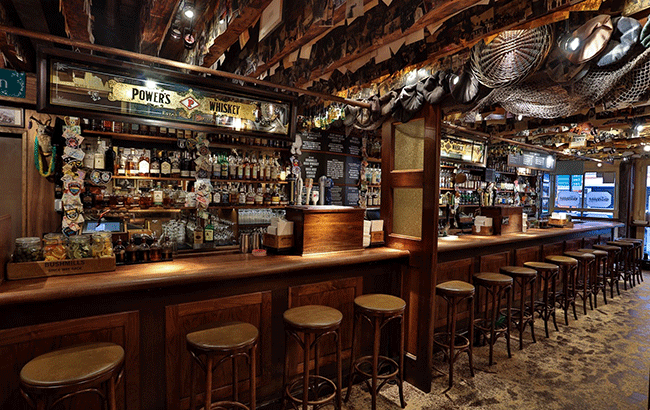
One of the pioneering cocktail pubs of this kind can be found in New York’s financial district. The Dead Rabbit was opened by Belfast‐born duo Sean Muldoon and Jack McGarry in 2013, and boasts a taproom and parlour over two storeys. Here, the offering is a celebration of the golden age of American cocktails, and the timelessness of the Irish pub. McGarry’s aim was to create an environment that embodies the venue’s slogan: tradition meets tomorrow. “I never bought into this sort of false dilemma, or the dichotomy between cocktails and pubs,” he tells me. “When we opened, people were like, ‘you can’t have cocktails in an Irish pub’, or ‘you can’t have food in an Irish pub’, or even some publicans going as far as to say ‘you can’t have music in an Irish pub’. And I’m like, well, who the fuck made these rules?”
He explains his bar was conceived in response to this. “Before Dead Rabbit, a lot of pubs in Ireland were stagnant, and the pub scene in America was completely ‘plastic Patty’,” he says, in reference to the US tendency to lean into Ireland’s stereotypes, with green‐dyed drinks and Dropkick Murphys on the jukebox.
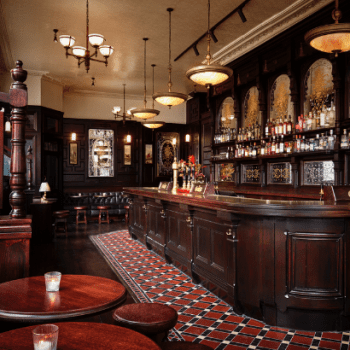
McGarry has modernised the idea of the Irish pub by placing the focus onto the bar’s cocktail offering. “Cocktails are hugely important,” he explains, noting them as one of the core pillars of his business. “Having the best‐in‐class programme of Guinness, Irish Coffees, Irish whiskeys and spirits – those are three big things. Then everything being focused around service, orientation, and speed. Hospitality is critical in a pub – comfortability, that feeling of home, and serving everything fast, because it drives me nuts in cocktail bars when it takes forever to get a drink, forever to get somebody’s attention. I hate friction in any type of setting, but particularly in a pub setting.”
In the UK the story is much the same. At The George, an 18th‐century Grade II‐listed pub in London’s Fitzrovia, complete with all the touch points of a traditional English boozer (wooden bar tops, ornate carpets), managing director Dominic Jacobs explains why the bar’s sophisticated cocktail programme has been given the same focus as its more traditional beer and ale offerings.
“The whole point for me starting these venues was because I think pubs in general have been stagnant for a very long time. Cocktails had sort of found their way into pubs in the early noughties, but you’d basically only get a Mojito or a Cosmopolitan – that kind of cocktail.”
Bar-quality cocktails
He adds: “Some pubs have an amazing wine list, but you’d never go there for a cocktail or a cask ale. Another pub might do good cocktails, but people will say, ‘well, it’s not a pub’. I really wanted to take every category, cask ale, craft beer, really great pints of commercial beer, great wine lists, and also bar‐quality cocktails, and put them together. But you have to create a drinks list that is ‘doable’ in a cocktail bar,” he warns.
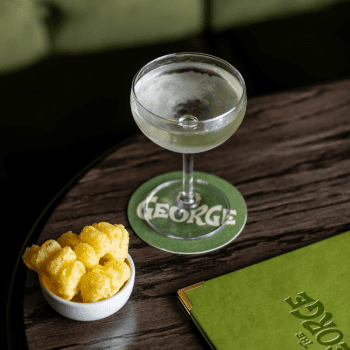
The George has received praise for its ‘tiny cocktails’, miniature versions of classics that allow punters to sample more from the menu, as well as its take on a Gibson Martini, which comes with pickled Monster Munch on the side. However, Jacobs notes that “if someone orders a load of cocktails that take ages to make, then that kind of ruins the pub experience for everyone”. That’s why, he clarifies, the bars have been designed around speed of service. “We pre‐bottle a lot of things, while not compromising on quality. We focus on Highballs, we’ve got some cocktails that we do on draft, and we make those ourselves if it makes sense to do so.”
I’m intrigued to know if Jacobs believes the British pub‐meets‐cocktail‐bar concept could work beyond the boundaries of metropolitan cities, or in countries where pub culture isn’t ‘a thing’. “The Brits have the world’s most revered drinking culture in the pub,” he says.
“If you talk to anyone about a drinking establishment, the first thing that comes to mind is the pub. And if we look at every city in the world, you will undoubtedly find an Irish pub. So, arguably, it is the best export that there is in the world.”
He is right. The pub is an establishment that appears to circumnavigate cultural boundaries, and with cocktail culture on the rise internationally, this combined concept style of venue has the ability to translate globally. For those curious to see how it’s done, a trip to Paris’s 3rd arrondissement will show how the French have achieved it. The Cambridge Public House describes itself as a British pub meets cocktail bar, and has all the aesthetic features you might expect to find in a modern pub, but its Parisian location means the cocktail influence shines stronger than it does back in Blighty.
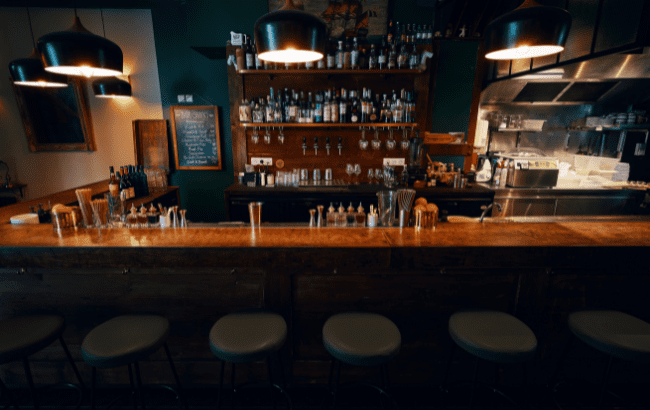
In the creation of this relaxed and friendly venue, co‐founder Hyacinthe Lescoët was inspired by London’s public houses, and Paris’s lack of anything similar. He says that while a lot of research went into every aspect of the bar, it was a welcoming speakeasy‐ style atmosphere that he was aiming to achieve to attract customers from all walks of life, as a traditional pub would.
“That’s the beauty of a pub to me,” McGarry concludes. “It’s a democratised, egalitarian sort of space; while you might be rubbing up against somebody who maybe drinks in five‐star hotels, you could also be rubbing up against somebody that’s just finished a shift on a building site – it’s people from all walks of life. We have a sign on the front of the door that says we are ‘exclusive of no one, inclusive of everyone’. And that, to me, is the heartbeat of a pub.”
Last spring, McGarry’s Dead Rabbit co-founder Sean Muldoon departed the bar to open a new Irish-themed venue in South Carolina, US.
Related news
Peddlers Gin launches cocktail contest
